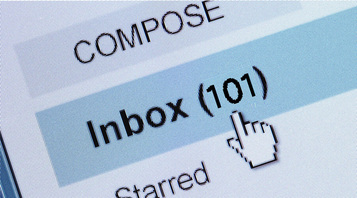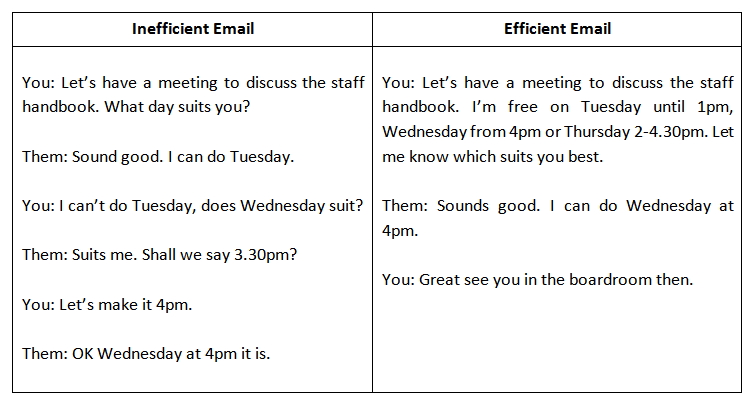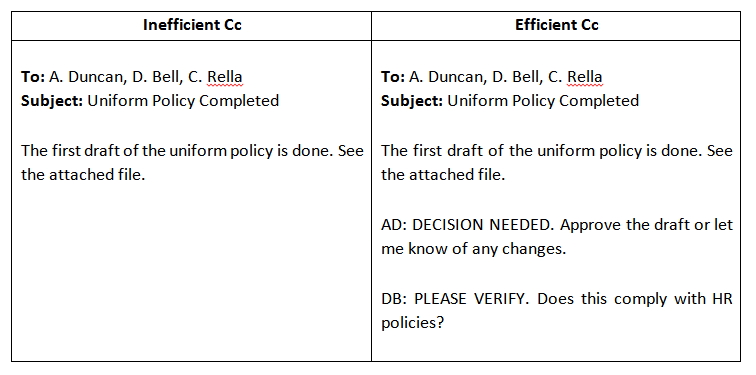
In this article, I include some simple but effective tips on how to manage emails to ensure the workplace can become more productive. As an employer, it is important lead by example when putting these practices and policies into place.
HOW TO REDUCE INCOMING EMAILS
The first step in managing emails is to reduce the number of unnecessary emails that one receives every day.
Turn off Social Media Notifications
It seems like a great idea to know when people have responded to a tweet or when someone has connected on LinkedIn, however the same notifications are ready and waiting when the account holder logs in to the relevant site. It’s all too easy to get distracted when a notification pops up, and usually a few minutes of checking what the comment is, turns into 20 minutes surfing the site to see what else is going on. Turn off all email notifications for social media sites in the account settings to reduce time wasted in the future.
Mass Unsubscribe from Unnecessary Newsletters
Most spam is prevented from hitting an inbox due to filters put in place by email providers, however over time, people sign up to more and more newsletters and coupon deals which land in inboxes on a daily basis. This happens a lot in the workplace as members of staff who are on computers all day every day, like to be updated on what’s happening in their industry.
All newsletters and coupon emails have an unsubscribe option on their emails; however a great tool for unsubscribing from unwanted emails in one go is www.unroll.me. I used this a few weeks ago and couldn’t believe that I had 72 subscription emails, most of which I was able to delete. A good suggestion would be to ask staff to do this with their work email address to see just how many emails they get that they don’t need to receive. Hopefully once these emails aren’t clogging up an inbox each morning, the more important emails will stand out.
Write Emails that Don’t Create more Emails
A major problem with emails in the workplace is those that take a few responses to get a date in the diary or a final answer. Train staff to be more efficient with their emails when organising meetings by avoiding open ended questions and instead offering times/dates that are optional, therefore they can agree on a time and carry on with tasks at hand. For example:
Only CC Employees who Need to be Included
There are times when more than one employee needs to be included in an email thread. Sometimes it’s to ensure all team members are ‘kept in the loop’, however every person added to an email conversation is a reply waiting to happen. Therefore it’s important to only include staff members that absolutely need to be in the thread and directly address them in the body of the email. For example:
Use a Non-Response Default Action
The majority of times emails are sent it is to let staff members or co-workers know of something happening within the workplace; however they don’t always need a reply. When writing an email with a question included, set up the question as follows: “I’m going to schedule a meeting with Client X in the boardroom for Thursday at 2pm. If I don’t hear back from you by end of play today, I’ll assume that’s fine.” This means that if no one has an issue they won’t feel the need to reply, resulting in less emails being circulated.
PROCESS EMAIL QUICKLY AND EFFICIENTLY
Once incoming email has been minimized, the next step is process the email one receives both quickly and efficiently.
Turn Off Notifications and Check Email at Defined Times Each Day
Focus can easily be broken when an email pings up on a computer or phone, and checking emails constantly can become addictive. Ensure notifications are turned off and set 2-3 specific times during the day to check emails. Let people know to phone if they need an urgent matter dealt with instantly. When the time comes to checking emails, take 30 minutes and ensure all focus is on this task at hand.
Reply, Delete, Action and Archive
During email sessions, get into the habit of performing one of the following four actions to ensure all emails are dealt with effectively.
- Reply: Respond to an email if it will take no more than two minutes. If the email doesn’t require a reply, but necessitates an action, add the action to a to-do list and archive the email.
- Delete: If an email doesn’t immediately make you feel you should reply to it, then it is not that important. If this is the case then delete or archive it.
- Action: Some emails require more thought and time before answering and therefore should be filed into another folder to flag up as something to come back to.
- Archive: Many emails are simply for informational purposes. If it doesn’t require a response or action then it should be archived so it can be found at a later date if need be.
Answer Briefly
To save time for both the sender and recipient of the email, it is best to keep responses brief. Email should be a balance between politeness and succinctness, however if an email does need more time and thought put into it, simply flag it to reply at a later stage with a more in depth responses.
Use Out of Office
When staff members are out of the office, whether it is for a day or for a few weeks, a brilliant tool to use is Out of Office. Text can be edited to ensure an automatic response to received email whilst letting the sender know they are not being ignored. Ensure that the response includes an alternative contact in case the matter is urgent.
The contents of this article are necessarily expressed in broad terms and limited to general information rather than detailed analyses or legal advice. Specialist professional advice should always be obtained to address legal and other issues arising in specific contexts.
---
We are currently carrying out a survey to get a better understanding of the role and influence of HR in Irish businesses and how we may be able to best facilitate them moving forward.
We'd really appreciate it if you could take the time to complete our questionnaire. It shouldn't take any more than 10 minutes and will go a long way in helping us understand the opportunities and challenges your company faces, so that we can adapt our services to meet your needs.
Please click the link below to complete begin the survey:
https://www.surveymonkey.com/r/XC3RPLT
On behalf of The HR Department, I would like to thank you again for your support.
---



 RSS Feed
RSS Feed